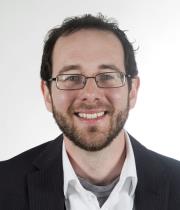 Dr. David Daughton is an applications scientist at Lake Shore focused on characterizing electronic materials and devices. He received his BS and MS in physics from the University of Delaware and his PhD in physics from the Ohio State University.
Dr. David Daughton is an applications scientist at Lake Shore focused on characterizing electronic materials and devices. He received his BS and MS in physics from the University of Delaware and his PhD in physics from the Ohio State University.
A: One of the first research projects I worked on as an undergrad was in low temperature physics. The first time I’d heard of Lake Shore was when I opened a drawer full of calibrated diode sensors made by the company. Throughout my research I’ve used various pieces of Lake Shore equipment, including their thermometry products and temperature controllers. After I received my PhD, I consulted with Lake Shore for a few months before becoming a full time applications scientist.
Q: What are your primary responsibilities at Lake Shore?
A: Applications scientists at Lake Shore often wear many different hats, but the most important role we play is as a liaison between the customer and the company’s product development teams. Since we all come from research backgrounds, we have first-hand experience with the challenges faced by our customers. We’ve been there, so to speak, so we have a good understanding of the needs of our customer base. We serve as the voice of the customer and work hand-in-hand with the product development teams to develop products that our customers can use, and perhaps most importantly, are happy to use.
Another of my roles is in customer service, answering customer questions, and helping solve application issues that come up in their research. As part of figuring out how to make products that will best meet customer needs, I am also using our existing products to measure samples and devices so that I can relate directly to the experiences of our customers.
Q: Please give us more details on your involvement in the product development process.
A: I work primarily on two major product categories: terahertz materials characterization systems and the probe station product line.
I was involved as a consultant in the earliest stages of the terahertz materials characterization project. My background in optics and materials characterization was useful in helping the team to identify critical applications and requirements for a terahertz characterization tool. Since joining Lake Shore full-time, I am helping to work out software details and product functions, performing validation measurements, and working with collaborators on potential new applications for the product.
For the probe station product line, I’m much more involved on the back end of the development process; frequently, I work with customers to configure our existing products for a specific application. Occasionally, interactions with our customers and their applications will lead to new products or accessories.
Q: What aspects of working at Lake Shore are most rewarding?
A: As applications scientists, we take pride in being a good resource to our customers. I particularly enjoy the opportunity to talk with graduate students, post-docs, and researchers who are trying to get a certain measurement done and help them get the results that they need. It’s exciting to see our customers win grants, publish, and move on with their careers.
Q: What developments in terahertz analysis do you expect to see in the coming years?
A: Terahertz is an emerging field, and I hope that it can develop into a reliable, non-destructive evaluation tool used across a wide variety of fields and applications. At Lake Shore, our goal is to make this a useful tool for electronic and magnetic materials characterization, but I can also see applications in security, chemical identification, and food science.
The next generation of development must include developing better, low-cost sources and detectors for terahertz frequency radiation, but I think once that happens, the technique is going to see a wide range of applicability. To place it all in perspective, 50 years ago lasers were just things that quirky scientists had in their labs, and now look at everything they’re used for. I can see that kind of development happening with terahertz.
